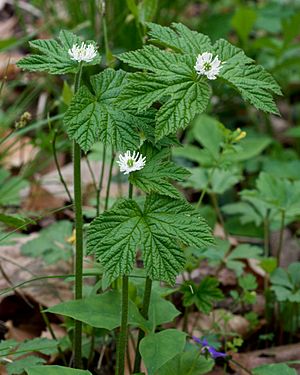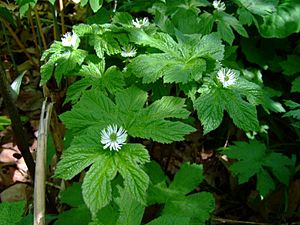Goldenseal facts for kids
Quick facts for kids Goldenseal |
|
|---|---|
 |
|
| Hydrastis canadensis | |
| Conservation status | |
| Scientific classification | |
| Genus: |
Hydrastis
|
| Species: |
canadensis
|
Goldenseal (Hydrastis canadensis) is also known as orangeroot or yellow puccoon. It is a perennial herb that belongs to the buttercup family, called Ranunculaceae. This plant naturally grows in southeastern Canada and the eastern United States.
You can spot goldenseal by its thick, yellow, and knotty rootstock (underground stem). Its stem above ground is purplish and hairy, while the part below ground is yellow and connects to the yellow rhizome. Goldenseal can grow new plants in two ways: by spreading its underground rhizome (cloning itself) or by seeds. It usually spreads more often by cloning.
It takes about 4 to 5 years for a goldenseal plant to be old enough to produce flowers. In its first stage, a seed sprouts and tiny leaves appear. This stage can last for a year or more. The second stage, usually in years two and three, involves growing a single leaf without a strong stem. Finally, in the third stage (after 4 to 5 years), the plant flowers and produces fruit.
There was once another plant from Japan called Hydrastis palmatum. However, scientists now usually place it in a different genus, and it is known as Glaucidium palmatum.
Contents
What Goldenseal Looks Like
Hydrastis canadensis is a plant that lives for many years. It grows from a yellow, horizontal underground stem called a rhizome, which has many knobby parts. Its stems are finely hairy, stand upright, and do not branch out. They can grow to be about 15 to 50 centimeters (6 to 20 inches) tall.
Plants that are ready to flower have one stem with two leaves that look like open hands. When it flowers in spring, it produces a single flower at the top. This flower has no petals but has three sepals (leaf-like parts that protect the bud) and many noticeable white pistils (the part that receives pollen). After the flower is pollinated, it grows into a red, raspberry-like fruit. Each fruit usually contains one or two seeds.
Where Goldenseal Grows
Goldenseal likes to grow in moist forests under deciduous trees (trees that lose their leaves in autumn). You can often find it in protected valleys or on rocky slopes. It does not seem to do well if the tree canopy above it is disturbed or if animals graze on it. Goldenseal can sometimes be found growing near other rare plants like Jeffersonia diphylla (twinleaf) and Dicentra canadensis (squirrel-corn).
Traditional Uses of Goldenseal
When Europeans first came to the Americas, many Native American tribes used goldenseal a lot. They used it both as a medicine and as a way to make yellow dye.
In 1798, Benjamin Smith Barton wrote about the Cherokee tribe using goldenseal to treat cancer. He also noted that it could be used as a bitter tonic (a medicine to make you feel stronger) and as a wash for eye problems. In the 1830s, it became popular among doctors who practiced Eclectic medicine. Tribes also used goldenseal for stomach problems, as an eyewash, and as a diuretic (something that makes you urinate more).
In the early 1900s, people used goldenseal as a yellow dye, a substance that tightens tissues (astringent), and to keep insects away.
Goldenseal and Modern Science
Goldenseal contains special natural chemicals called isoquinoline alkaloids. Some of these are hydrastine and berberine. These chemicals are not very good at dissolving in water but dissolve well in alcohol.
For goldenseal to be sold as a supplement, the United States Pharmacopeia requires it to have at least 2% hydrastine and 2.5% berberine. In Europe, the rules are even stricter, requiring at least 2.5% hydrastine and 3% berberine. Goldenseal plants usually have 1.5% to 5% hydrastine and 0.5% to 4.5% berberine. The rhizomes (underground stems) are harvested because they have higher amounts of these chemicals than the parts of the plant above ground.
Some studies suggest that goldenseal might help fight bacteria even better than berberine alone. This could be because it stops bacteria from pumping out helpful substances.
Protecting Goldenseal
Goldenseal became very popular in the mid-1800s. By 1905, there was much less of it because too many plants were picked, and its natural homes were destroyed.
Wild goldenseal is now listed in Appendix II of CITES (Convention on International Trade in Endangered Species). This means it is protected. You cannot harvest it from public land, and you might need a permit to export it. The United States Fish and Wildlife Service suggests that people who dig up goldenseal keep track of their sales and harvests to prove they are legal.
Canada and 17 of the 27 U.S. states where goldenseal grows naturally have said it is threatened, vulnerable, or uncommon. More than 60 million goldenseal plants are picked each year without being replaced. Even though goldenseal grows in many places, it is found in small amounts in each area. The main area where it grows is the Ohio River Valley, but its population there has dropped by almost half. A type of mining called mountain top removal has also put wild goldenseal at great risk by destroying its habitat.
Many herbalists suggest being careful when buying products with goldenseal. This is because some might have been harvested in a way that is not sustainable. It is better to choose products from plants that were grown on organic farms.
There are other plants that contain berberine and can be used instead of goldenseal. These include Chinese coptis, yellowroot, or Oregon grape root.
Growing Goldenseal
As of 1998, only a small amount (2.4%) of goldenseal came from cultivated farms, not from wild harvesting. However, this number was expected to grow. Because of worries about protecting the plant, more research has been done on how to successfully grow goldenseal for sale.
Goldenseal often grows in patches where new plants sprout from connected underground stems. This means you can move parts of the rhizome to grow new plants in a cultivated area. Growing goldenseal from seeds is also possible. It costs less and creates more variety in the plants, but it can be tricky and hard to predict.
Goldenseal can be grown commercially in forests, which is called agroforestry. This method tries to copy the plant's natural environment. It can also be grown on farms using artificial shade covers. Another way to grow goldenseal is in a controlled environment like a greenhouse. Here, things like light, water, and temperature are carefully controlled. Scientists can also use special methods to choose the best plants and increase how much goldenseal grows and how strong its chemicals are.
Growing goldenseal in controlled environments can greatly speed up how long it takes for the plant to be ready for harvest. In forests, plants might double in size every three to five years. But in special growth chambers, they can double in size every 15 weeks! They can even grow three times faster in coarse soil. New plants can be started every 30 days to grow many goldenseal plants quickly.
Another idea is to grow goldenseal in new regions. One experiment grew goldenseal for six years in a warm climate in New Zealand. The amount of goldenseal harvested in the sixth year was 74% higher than in the fourth year, which is when it is usually harvested. The overall growth of goldenseal in New Zealand was similar to that in the United States. Also, the amounts of hydrastine and berberine were within the required standards for America and Europe. Growing goldenseal in places like New Zealand, which have similar climates to its native home, could help keep its population healthy.
See also
In Spanish: Hydrastis canadensis para niños



